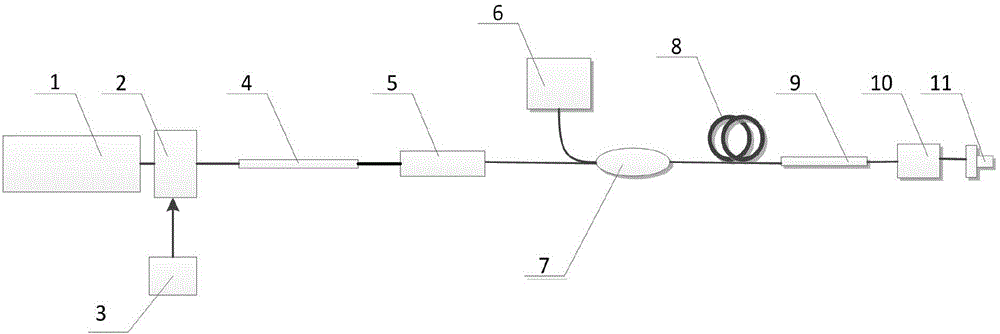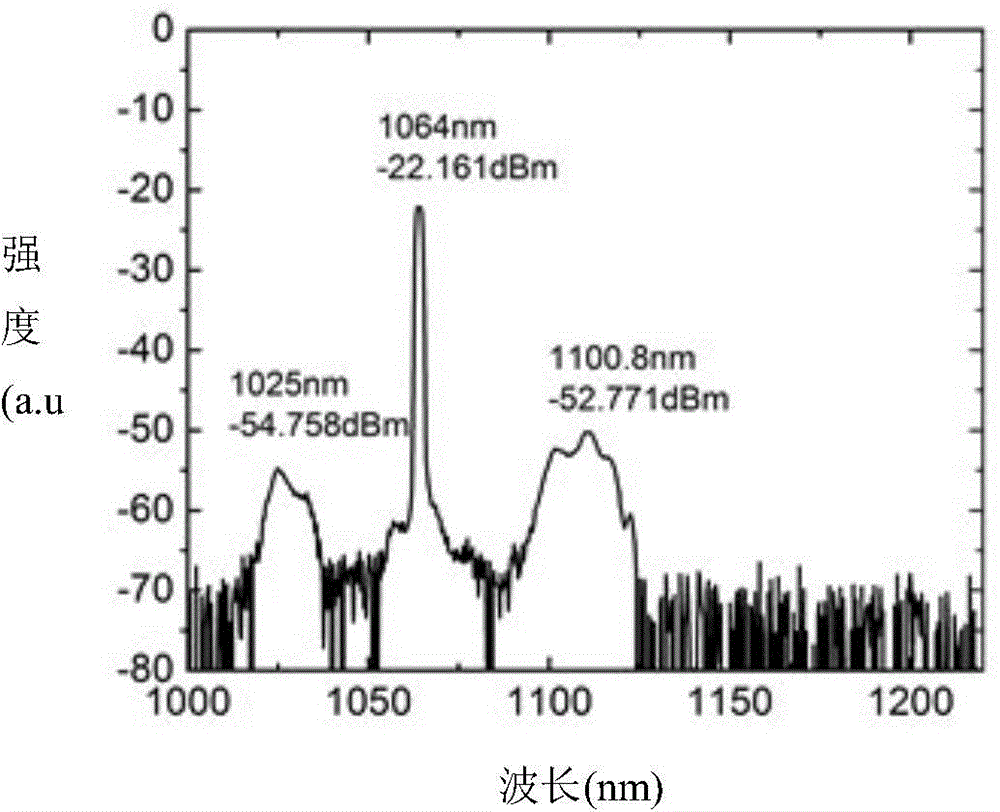Single-fiber-type CARS excitation source device and realization method based on two-stage non-linear tuning
A technology of nonlinear tuning and realization method, which is applied in the direction of nonlinear optics, measuring devices, material excitation analysis, etc., can solve the problems that hinder the wide application of CARS, slow wavelength tuning speed, huge system, etc., and achieve the expansion of molecular vibration wave number range, The effect of fast tuning speed and reduced implementation difficulty
- Summary
- Abstract
- Description
- Claims
- Application Information
AI Technical Summary
Problems solved by technology
Method used
Image
Examples
Embodiment 1
[0033] Implementation example 1: A single-fiber CARS excitation source device based on dual-stage nonlinear tuning
[0034] Such as figure 1 As shown, the device includes a femtosecond fiber laser source 1, an electronically controlled optical power attenuator 2, a voltage controller 3, a primary tuner 4, a pulse stretcher 5, a pump laser source 6, a wavelength division multiplexer 7, Gain fiber 8, secondary tuner 9, optical filter 10 and output port 11.
[0035] The femtosecond linearly polarized pulsed light output by the femtosecond fiber laser source 1 enters the electronically controlled optical power attenuator 2 as a Stokes optical pulse seed source, and the optical power attenuation value is controlled by the voltage controller 3, and the optical pulse after optical power attenuation Entering the primary tuner 4 to realize power-controlled optical pulse wavelength tuning, the output pulsed light is stretched by the pulse stretcher 5, and then combined with the pumped ...
Embodiment 2
[0036] Implementation example 2: A method for realizing a single-fiber CARS excitation source based on dual-stage nonlinear tuning
[0037] Using femtosecond fiber laser light source to provide femtosecond level linearly polarized pulse light, used as the Stokes light pulse seed source of CARS source, the pulse width range is 50-200fs, the center wavelength is 1030-1064nm, and the repetition frequency is 10MHz-100MHz. Pulse energy greater than 1nJ. The voltage controller outputs the control voltage to control the attenuation value of the electronically controlled optical power attenuator composed of the phase retarder and the polarizer to realize the optical power attenuation adjustment. The primary tuner is composed of photonic crystal fiber. By controlling the injected light power, the soliton self-frequency shift nonlinear effect of photonic crystal fiber is used to realize the tuning of Stokes optical pulse, and the tuning wavelength range is 10-40nm. The pulse stretcher ...
Embodiment 3
[0040] Implementation Example 3: Application Example
[0041] The CARS source outputs a signal light pulse and a Stokes light pulse, wherein the signal light pulse is used as a pump light pulse of the CARS source. Under the action of the pump light pulse of the CARS source and the two light pulses of the Stokes light pulse, the molecular vibration in the analyte that resonates with the frequency difference between the pump light pulse and the Stokes light pulse is first excited, so that It generates resonance, and then the resonant molecular vibration converts a large amount of pump light output by the CARS source into anti-Stokes light to realize the detection of specific molecules. Through two-stage tuning, the pump light pulse and Stokes light pulse of the CARS source cover a wavenumber of 400-4000cm -1 Molecular vibration, so as to meet the measurement of molecular vibration spectrum and excitation imaging of specific molecules in biochemistry.
PUM
| Property | Measurement | Unit |
|---|---|---|
| Pulse width | aaaaa | aaaaa |
| Wavelength | aaaaa | aaaaa |
| Energy | aaaaa | aaaaa |
Abstract
Description
Claims
Application Information
 Login to View More
Login to View More - R&D
- Intellectual Property
- Life Sciences
- Materials
- Tech Scout
- Unparalleled Data Quality
- Higher Quality Content
- 60% Fewer Hallucinations
Browse by: Latest US Patents, China's latest patents, Technical Efficacy Thesaurus, Application Domain, Technology Topic, Popular Technical Reports.
© 2025 PatSnap. All rights reserved.Legal|Privacy policy|Modern Slavery Act Transparency Statement|Sitemap|About US| Contact US: help@patsnap.com



